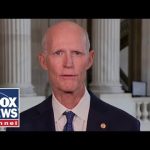**The Secret Service’s Swing and a Miss: Questioning Security Protocols After Trump’s Golf Day Incident**
In an alarming turn of events for the nation, former President Donald Trump was recently involved in a security situation that has left many scratching their heads and raising eyebrows. The incident, which took place while Trump was enjoying a round of golf at a popular club, has sparked a flurry of questions regarding the effectiveness of the Secret Service and its protective measures. With video surfacing from six years ago showing the former president on the greens, concerns about vulnerabilities in the agency’s operation are now front and center.
The rollercoaster of events began when a person was spotted lurking nearby, hidden among the trees while President Trump spent a leisurely afternoon playing golf. The Secret Service reportedly failed to detect this individual, who was close enough to warrant attention and prompt an evacuation of Trump to a safer location. This has left many to wonder: if a dedicated team is charged with keeping the former president safe, how could they have missed a person in such proximity? It seems like an open-and-shut case of breach—unless, of course, you consider the agency’s claims of operational excellence.
Chris Swecker, a former assistant director of the FBI, noted that while the acting director of the Secret Service insisted their methodologies were effective, observers had a different take. The question looms large: are these protective operations as robust as they should be? Resources may be plentiful on paper, but when it comes to protection, management and execution appear to be where the blame lies. Swecker pointed out that if protection is the core mission, then resources should be reallocated to where they are needed most—especially in light of the current climate of threats against figures like Trump.
Interestingly enough, the discussion turned to the perimeter security of the golf club itself. As many in the room calmly noted, if the venue does not have stringent barriers, it is almost natural for unauthorized individuals to gain access. With Trump’s golfing habits well-known, some experts wondered why the security apparatus did not treat the occasion with extra caution. There has been increasing talk about whether or not off-the-record movements—impromptu schedules that are not disclosed—were being implemented properly, leading to this potential lapse in security protocol.
Moreover, the conversation took a curious tangent as comparisons were made between protection levels for President Trump and those for Vice President Kamala Harris. Although both figures may require security, it appears that the two may have disparities in terms of how many dedicated agents accompany them. Questions linger about whether or not this discrepancy is reasonable given that Trump often interacts with large crowds, while Harris tends to keep her distance. The level of risk is certainly higher for someone whose very presence may inspire passionate reactions from his supporters or detractors alike.
Ultimately, the episode raises serious concerns about the Secret Service and its capacity to adapt to contemporary threats. What actions will be taken to ensure this doesn’t happen again? The lack of preventative measures and the apparent complacency are alarming, particularly when real lives hang in the balance. With a commitment to uphold the highest standards of security, it’s a wonder why the agency was caught flat-footed during such a critical moment. The debate rages on, and as accessory photos from outings continue to surface, the importance of vigilance cannot be overstated—especially as we head towards 2024. If the past is any lesson, it’s clear that protection is critical, and effective methodologies must be at the forefront of national security strategies.




